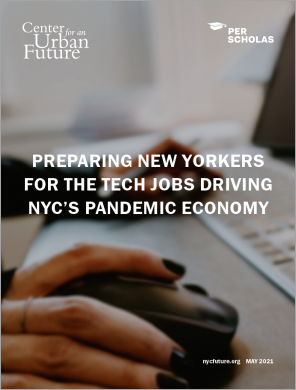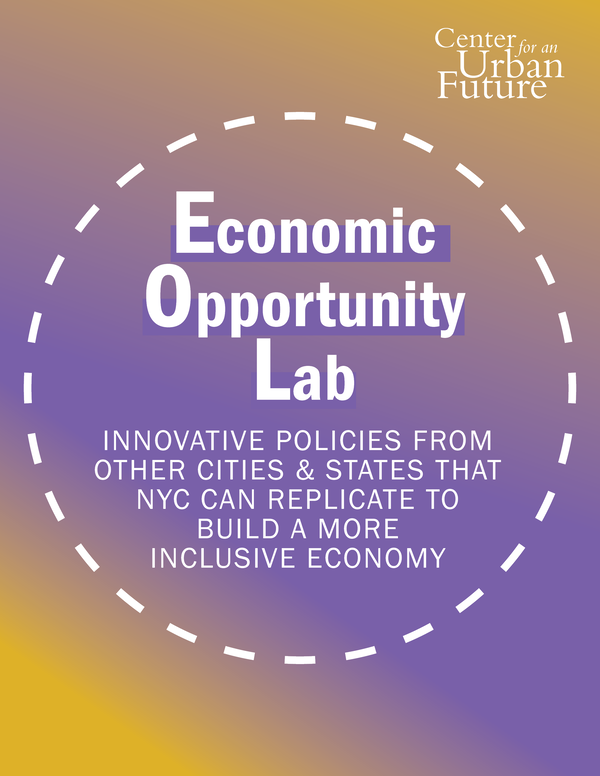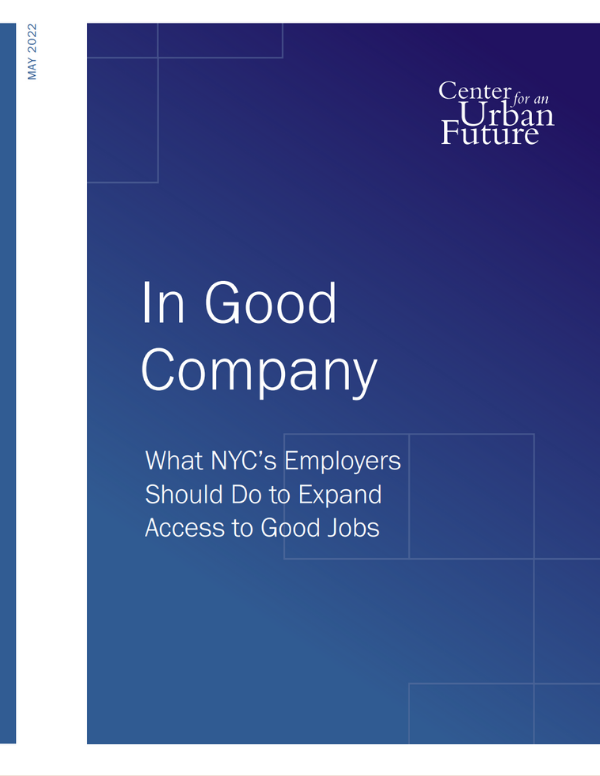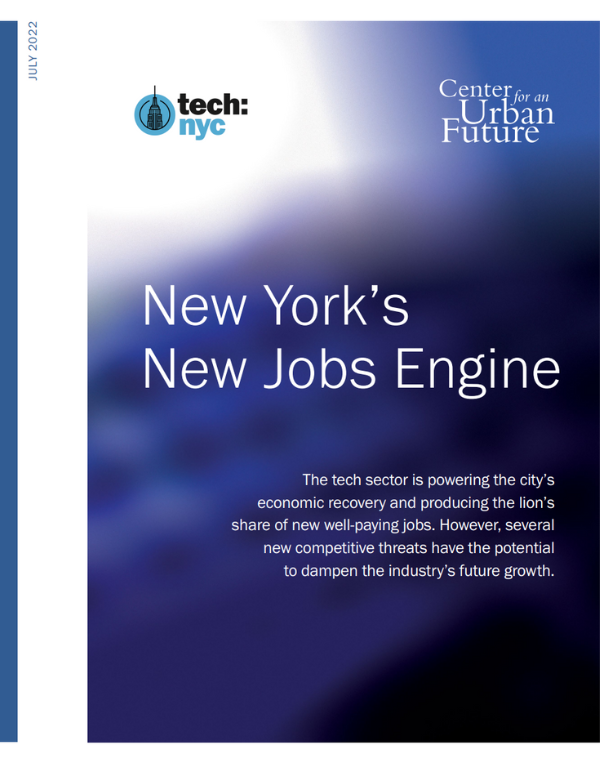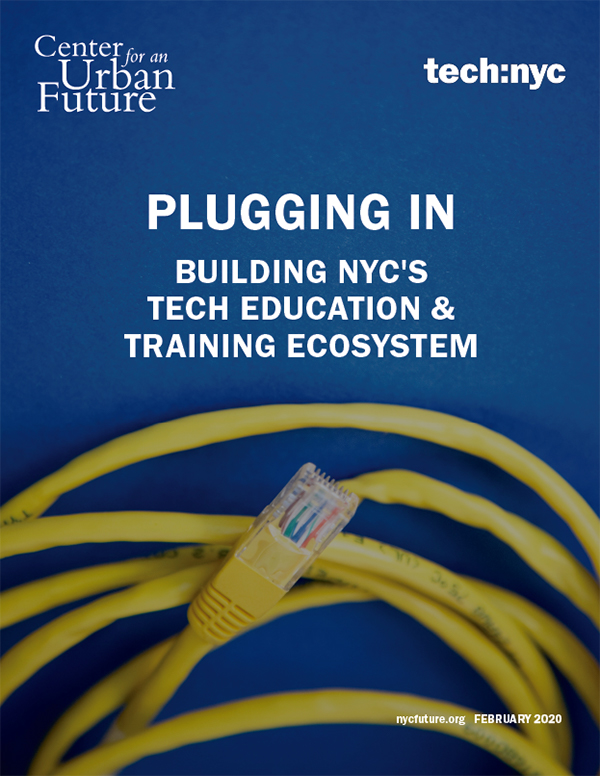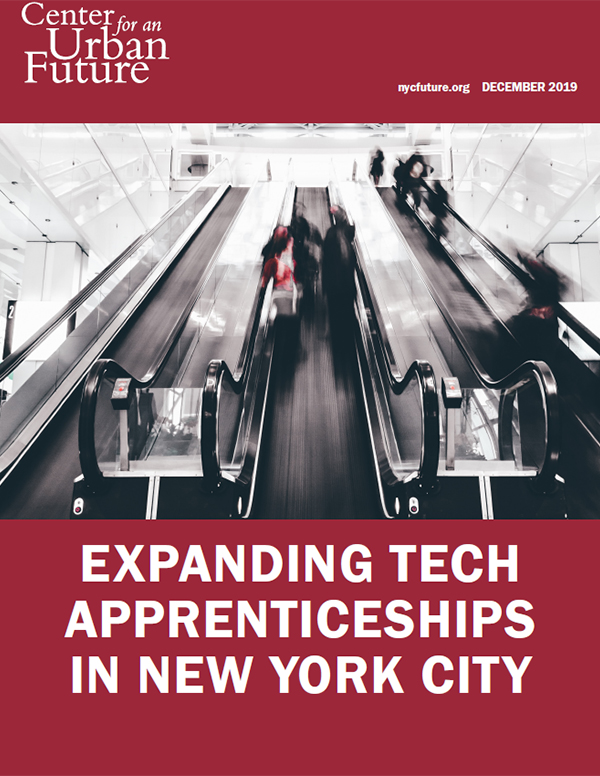- The following are recommendations from Preparing New Yorkers for the Tech Jobs Driving NYC’s Pandemic Economy
- Read the full report (PDF)
This analysis makes it clear that tech jobs will be key to New York’s economic recovery, but also that new city investments in tech skills-building programs are needed to ensure that the New Yorkers most impacted by the pandemic are able to access these in-demand jobs. To create a tech sector that reflects the diversity of New York while greatly expanding access to economic opportunity, city leaders should set ambitious goals and commit to a set of investments that help expand and improve the tech skills-building ecosystem. City government officials should consider the following ten policy recommendations:
- Scale up tech training with a focus on programs that develop in-depth, career-ready skills. While there is much city policymakers can do to train New Yorkers for opportunities in tech, one clear starting point should be to double or triple the capacity of the specific type of tech training programs that are in short supply today: multi-week, in-depth training programs focused on applied technical skills and real-world career readiness—and informed by specific employer needs—that consistently lead to employment, retention, wage gains, and career advancement. Today, New York City is home to a wide variety of workforce development programs and other skills-building initiatives focused on basic computer and technical skills. But relatively few free and low-cost adult training programs are focused on career-ready tech skills, and the programs that do are serving from a few dozen to a few hundred New Yorkers each year. To help more working adults access opportunities in the tech sector, policymakers should focus on scaling up the relatively small number of intensive, in-depth tech training programs that consistently lead to employment in technical occupations and provide opportunities for career advancement.
- Develop and fund links from the numerous computer literacy and basic digital skills-building programs to the in-depth programs that can lead to employment. Although working adults have numerous options for acquiring basic computer skills and digital skills training, very few of these programs have connections across the broader skills-building ecosystem. To better leverage the ecosystem that already exists, New York City needs to incentivize and fund partnerships across the continuum of skills-building offerings, from basic computer skills to in-depth, career-oriented programs. For instance, new city RFPs should incentivize partnerships between libraries and other training providers focused on basic digital skills and entry-level, career-oriented training programs aligned with employer needs. These linkages can help ensure that New Yorkers have a logical next step in their skills-building pathway and support outreach efforts by career-focused training providers into low-income communities.
- Expand the number of bridge programs to provide crucial new on-ramps to further tech education and training for New Yorkers with fundamental skills needs. Today, more than 1.1 million adults in New York City lack a high school diploma, and more than 1.8 million speak English less than very well. Due to these and other skills barriers, no matter how much the city does to grow the number of high-quality, career-focused tech training programs, hundreds of thousands of New Yorkers will remain unable to access them. The city should invest at least $70 million annually in bridge programs that can serve as key on-ramps into effective education and training programs for New Yorkers with lower levels of skills and formal education.
- Close the geographic gaps in tech education and skills-building programs. Although New York City’s tech skills-building ecosystem is larger than ever, serious geographic gaps exist across the city. It’s understandable that a large concentration of programs exists in Manhattan, for reasons including proximity to employers and accessibility across multiple transit lines. But for both K–12 and adult workforce programs to reach more low-income New Yorkers, more needs to be done to place programs in communities with few, if any, options for tech skills-building today. Efforts could include grants for existing organizations to create new program locations in underserved locations and co-location of programs in community-based infrastructure like libraries and schools.
- Establish dedicated funding streams for workforce development programs. Last November, San Antonio began reallocating a small percentage of sales tax to go to workforce development, including job training and scholarships. Massachusetts has a Workforce Training Fund, funded by a small state payroll tax. New York City doesn't have anything like this. Funding for workforce development programs is largely discretionary, which leaves out too many programs and potential participants. Skills-training and workforce development providers need a more reliable and sustainable funding source in order to be responsive to the needs of workers and employees in an ever-shifting post-pandemic economy.
- Prioritize long-term investments in K–12 computing education. With thousands of New Yorkers out of work amid a fast-changing job market, immediate investment is needed to scale up the city’s limited supply of in-depth training programs aligned with tech careers. But this urgent response to the current economic crisis should be accompanied by continued long-term investment in expanding and improving K–12 computing education. While New Yorkers of all ages can benefit from tech skills-building initiatives, long-term investments in computing education are essential in order to tackle the city’s persistent opportunity gap at the root. By ensuring that every student has access to effective, age-appropriate computing education—including the core concepts of computational thinking—New York City can greatly expand the pipeline into tech careers by building skills, interests, and confidence from the earliest years of a New Yorker’s life.
- Provide support for upskilling both within programs and for alumni for years to come. Skills-training and workforce development providers need to offer upskilling to help alumni and current students break into tech and stay competitive through economic turbulence. The shifting needs of tech employers demand that training programs have the resources they need to be flexible and adaptable. The city should work with the private sector to fund and scale these kinds of efforts to help more New Yorkers enter the job market and stay in their chosen careers over the long term.
- Offer capital/infrastructure dollars for technology. Providing tech skills training is expensive, and the vast majority of provider revenue goes to programming needs, like instructor salaries and alumni support. This leaves almost nothing extra for investments in crucial capacity-building infrastructure. The city should invest in that infrastructure, such as lendable technology and hot spots, as well as provide support for building out training facilities for when in-person programs resume.
- Boost support for non-tuition barriers like childcare, Internet access, and MetroCard costs. Cost barriers interfere with New Yorkers’ ability to access continuing education and workforce development programs—even ones that are tuition-free. CUNY offers great continuing-education programs “that people can’t afford,” says Weinstock of LaGuardia Community College, noting that little aid is available for continuing education. “People can’t even pay for a free program,” she says. “We’ve lost people from free bridge programs because they couldn’t take the time away from childcare.” The city should step up its support for skills-training and workforce development providers, including within CUNY, to help New Yorkers overcome the many non-tuition roadblocks to career advancement, from lack of childcare or at-home WiFi to the cost of transportation.
Many New Yorkers who are searching for a job face similar barriers, particularly lack of connectivity and technology, that stymie their progress. In 2019, 30 percent of NYC households overall, 44 percent of low-income households, and 30 percent of Black and Hispanic households did not have broadband internet access. The city made good progress toward achieving universal access last year by launching and further investing in the Internet Master Plan, and recently pushed 5G companies to expand connectivity in neighborhoods hit hardest by COVID. These and other efforts should continue, with an emphasis on closing the broadband access and affordability gaps in low-income communities and among older adults. - Increase funding for professional development for teachers, trainers, and nonprofit staff. To help address New York City’s technology skills-building needs at scale, the city’s educators—including K-12 teachers and the staff of community-based workforce development organizations—need access to high-quality professional development. We heard from nonprofit organizations whose staff have master’s degrees, but struggle to use and discuss fundamental digital tools. Likewise, K-12 teachers need professional development as well, in order to embed the principles of computing education in every classroom—not just those schools with dedicated computer science programs. In addition, instructors at workforce development organizations need access to continuous industry-relevant career education as well, to ensure that upskilling initiatives remain effective and current. Furthermore, training providers tell us that while they want to bring alumni back as instructors, they struggle to compete with tech-sector salaries. The city can help address these challenges by investing in professional development and setting ambitious goals for the Department of Education, which can help expand the pool of capable educators and instructors from pre-kindergarten through adult-focused career training.

